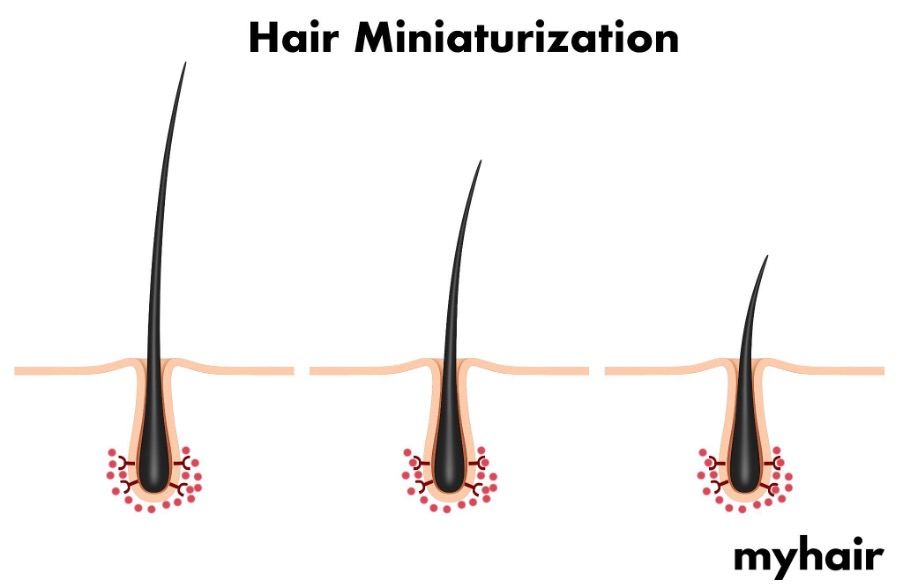Diabetes affects more than 420 million men, women, and children around the world. Some people are born with this condition, while others develop it later on in life.
Diabetes, which causes your body to develop elevated blood sugar, is generally considered to be a metabolic disorder. However, this condition also affects a number of other parts of your body, particularly your cardiovascular system. When essential bodily functions like circulation are altered, this can also affect your skin and hair, triggering or worsening existing hair loss.
Can diabetes cause hair loss?
Diabetes doesn’t exactly cause hair loss – but both the disease and its treatment can make you more prone to experiencing this problem. According to studies in the Journal of Pakistan Association of Dermatologists, JAMA, and the Medical Hypotheses journal, diabetes and related issues, like insulin resistance and metabolic syndrome, have been linked to:
- Androgenic alopecia, which is more commonly known as pattern hair loss
- Alopecia areata, an autoimmune issue that causes distinct round patches of hair loss
- Telogen effluvium, also known as stress-related hair loss
- Medication-related hair loss
Type 1 vs. type 2 diabetes and hair loss
There are two main types of diabetes: type 1 and type 2. There are other types of diabetes, but they are much rarer. These include conditions like cystic fibrosis diabetes, steroid-induced diabetes, and latent autoimmune diabetes.
According to Diabetes UK, type 1 diabetes is a genetic condition that causes the body to attack pancreatic cells, preventing them from making insulin. It affects about 8 percent of people with diabetes.
People with type 1 diabetes are thought to be particularly prone to experiencing alopecia areata, an autoimmune form of hair loss that causes your body to attack hair follicles. People can experience this type of hair loss on isolated patches of hair, across their entire scalp, or across their entire bodies. Treatment usually requires steroids and other immunosuppressants prescribed by your doctor.
Type 2 diabetes affects about 90 percent of people with diabetes. It usually develops over time and can be managed through lifestyle changes, dietary changes, exercise, and medication.
People with type 2 diabetes and related health issues are more often linked to androgenic alopecia. It’s well known that diabetes affects the circulatory system. However, it may specifically be insulin resistance that affects blood flow, which in turn prevents hair follicles from getting enough blood, oxygen, and nutrients – and accelerates the progression toward balding.
Common types of hair loss with diabetes
All diabetics can be affected by stress-related hair loss and medication-related hair loss. Fortunately, both of these conditions can be fairly easy to treat.
If you’re dealing with medication-related hair loss, you’ll need to talk to your doctor to figure out an equivalent alternative medication you can start using. Hair will usually grow back on its own after a few months once you’ve switched to the new drug. According to studies in the Journal of European Academy of Dermatology and Venerology and Journal of Family Medicine and Primary Care, people with diabetes can experience hair loss due to a variety of medications, including diabetes management drugs like teneligliptin and metformin.
Similarly, stress-related hair loss will also usually go away on its own – as long as the stressor has been dealt with. Stressors can be both mental and physical. In the case of diabetics, the stressor can be as minimal as dehydration – which is fairly easy to treat – or it could be related to blood sugar mismanagement, which can require a lot more trial and error to work through.
But since androgenic alopecia is the most common type of hair loss, chances are that diabetes or not, you may be seeing symptoms related to that condition.
Treating pattern hair loss when you have diabetes
As the most common form of hair loss, androgenic alopecia has several treatments you can choose from. The FDA has approved three very different options for male pattern hair loss: minoxidil, finasteride, and low-level laser therapy. If none of these work for you, you can also consider surgical options, like hair transplants, and clinic-based procedures, like platelet-rich plasma therapy treatments.
Using minoxidil
Minoxidil is a topical hair loss treatment that works by improving blood flow to your scalp. This allows more blood, oxygen, and nutrients to reach your hair follicles. It’s generally thought to be most effective in men with early to mid-stage pattern hair loss.
According to Statpearls Publishing, minoxidil is FDA-approved as a treatment for androgenic alopecia. It’s also sometimes used off-label for other types of hair loss, including alopecia areata and stress-related hair loss.
Minoxidil is sold as a liquid serum and a foam in concentrations of 2 and 5 percent. The 5 percent solution is thought to be the most effective for men, but both concentrations have been shown to help stop the progression of hair loss and promote the regrowth of thicker, stronger hairs. Side effects associated with minoxidil are localized to the scalp and tend to be limited to issues like itchiness and irritation.
Taking finasteride
Finasteride is an oral medication that’s FDA-approved for the treatment of male pattern hair loss. Like minoxidil, it’s usually recommended for men with early to mid-stage androgenic alopecia. This drug comes in 1-milligram pills that are meant to be taken once a day. A review in the Lasers in Medical Science says that finasteride works as a DHT blocker, counteracting the hormonal component of pattern hair loss.
Finasteride is effective at stopping hair loss and improving hair growth. However, since it’s taken orally, the way this medication works is systemic. This means that it can cause a wider range of issues that have the potential to affect multiple parts of the body. Finasteride side effects include unpleasant issues like impotence and changes in libido.
Getting low-level laser therapy
Low-level laser therapy – also known as laser hair therapy or LLLT – is a biostimulatory light therapy treatment cleared by the FDA. It can be administered at home, using devices like caps, brushes, and combs, or you can receive treatments at a clinic – where you’re more likely to see laser hair therapy helmets and other professional-grade devices.
Laser hair therapy is a good choice for people with early to mid-stage hair loss symptoms – particularly people who don’t want to risk finasteride’s sexual side effects and can’t use minoxidil. Like minoxidil, LLLT is thought to improve blood flow to the scalp and can encourage healthier hair regrowth.
Despite being the newest FDA-approved treatment for androgenic alopecia, laser hair therapy has shown great promise in treating pattern hair loss. In fact, according to a study in the Journal of Dermatological Treatment, it’s currently also the most effective FDA-approved hair loss treatment available.
Having a hair transplant
There are two main types of hair transplant surgeries: follicular unit extraction (FUE) and follicular unit transplantation (FUT). FUE involves the excision of hair follicles from the back of the head where you have no hair loss symptoms. They’re then relocated to your crown, temples, hairline, and any other areas where you’re balding. FUT is a similar procedure – but rather than extracting follicles one at a time, this surgery extracts a strip of skin from the back of your head and harvests follicles from it.
Hair transplants are best suited for people with mid to late-stage symptoms of pattern hair loss. Since androgenic alopecia is progressive, it’s not advisable to get a hair transplant when you first start seeing symptoms. And if you do, be prepared to pay for a second or third transplant surgery sometime in the future.
How do you stop hair loss from diabetes?
While it may seem challenging to stop hair loss when you’re already dealing with a complex condition like diabetes, it’s completely possible. The first step in your battle is to identify the type of hair loss you’re experiencing.
People with diabetes are likely to develop several different types of hair loss, including medication-related hair loss, stress-related hair loss, androgenic alopecia, and alopecia areata. Some types of hair loss – like stress-related hair loss – can go away on their own, while others – like androgenic alopecia – will require you to start using a hair loss treatment.
If you’re experiencing androgenic alopecia, the good news is that you have multiple FDA-approved treatment options available. Minoxidil, finasteride, and laser hair therapy have all been proven to stop the progression of hair loss and help you grow back thick, strong, healthy hair.
Hair loss treatments tend to be most effective for people with early to mid-stage pattern hair loss. If you’ve let your symptoms progress further, you may want to consider getting hair transplant surgery, too. But if you can, try to treat hair loss early – the sooner you start a treatment, the more effective it’s likely to be.





